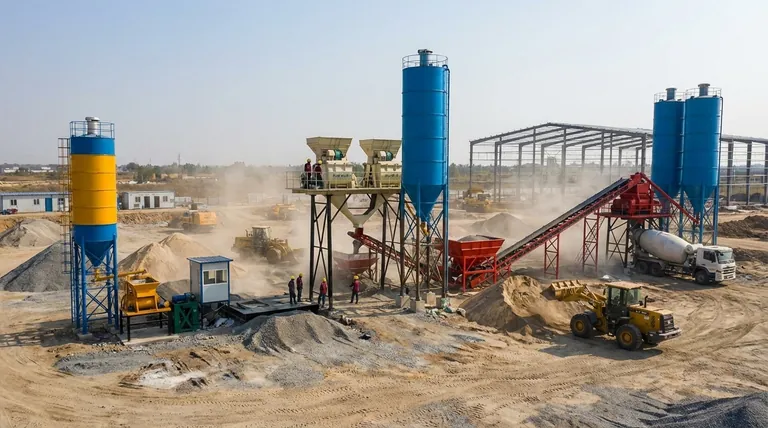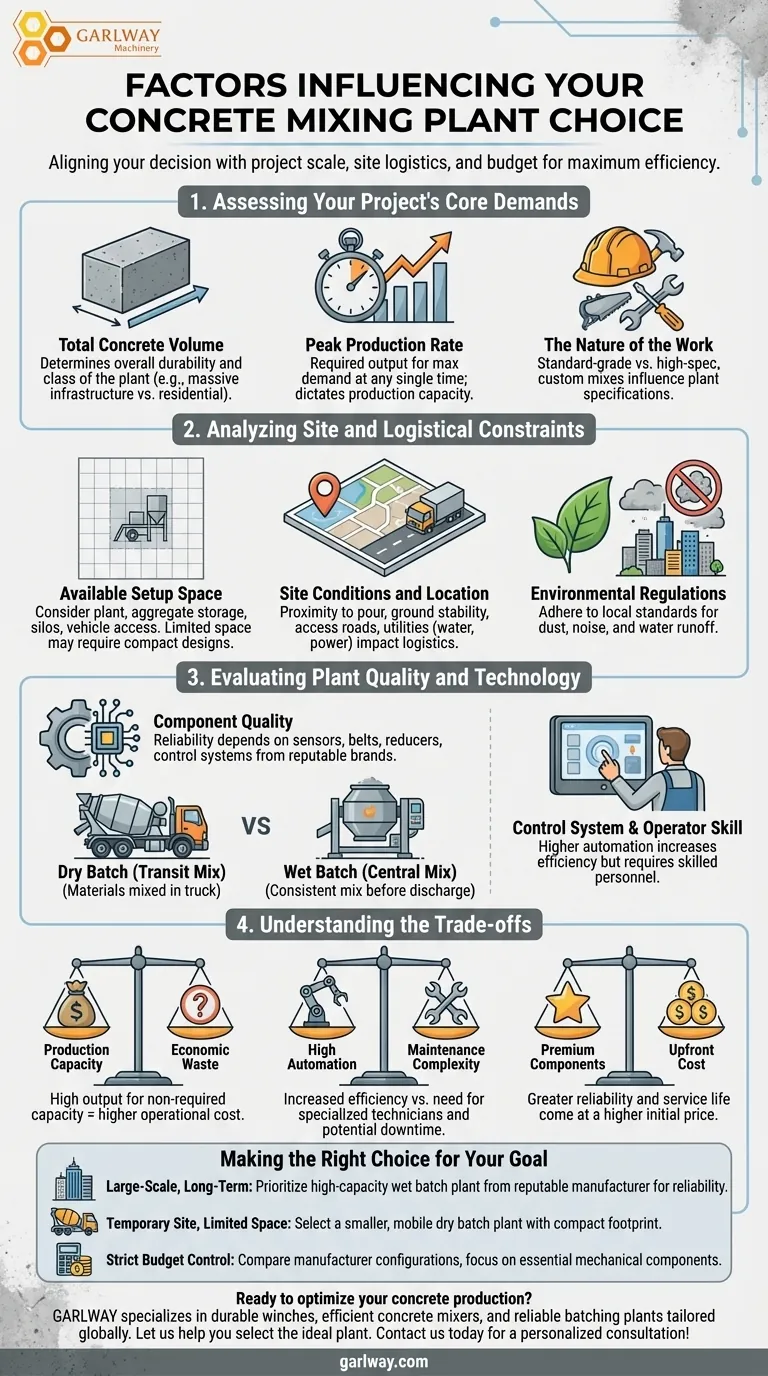Choosing the right concrete mixing plant is a critical decision that hinges on a careful analysis of your project's specific requirements, site limitations, and desired production output. The key factors to consider are the total volume of concrete needed, the maximum required at any one time, the available space on-site, the type of work being performed, and the quality of the plant's components and control system.
The optimal concrete mixing plant is not simply the one with the highest theoretical output. It is the one that aligns perfectly with your project's scale, logistical constraints, and budget, ensuring maximum efficiency and preventing costly over-investment.

Assessing Your Project's Core Demands
Before evaluating any equipment, you must first define the scope of your work. The plant is a tool, and its specifications must match the job it's intended to do.
Total Concrete Volume
The total volume of concrete required over the project's entire lifecycle is the first major consideration. This helps determine the overall durability and class of plant you need.
A massive infrastructure project demands a different kind of plant than a small residential development.
Peak Production Rate
Beyond the total volume, you must know the maximum amount of concrete needed at any single time. A project with large, continuous pours has a much higher peak demand than one with intermittent, smaller needs.
This figure directly influences the required production capacity (measured in cubic meters or yards per hour) of the plant.
The Nature of the Work
The type of construction also dictates plant choice. A project requiring standard-grade concrete for foundations has different needs than one demanding high-spec, custom mixes for architectural elements.
Analyzing Site and Logistical Constraints
The physical environment of your worksite imposes non-negotiable limits on your plant options. Ignoring these realities can lead to significant operational failures.
Available Setup Space
The physical footprint available for the plant is a primary constraint. You must account for the plant itself, aggregate storage, cement silos, and vehicle access.
Limited space may necessitate a more compact or vertically oriented plant design.
Site Conditions and Location
The proximity of the plant to the actual pour location is crucial for maintaining concrete quality. Remote or difficult-to-access sites have different logistical challenges than urban ones.
Consider factors like ground stability, access roads for delivery trucks, and availability of utilities like water and power.
Environmental Regulations
Modern construction must adhere to strict environmental standards. Your plant choice must account for local regulations regarding dust, noise, and water runoff to ensure legal and sustainable operation.
Evaluating Plant Quality and Technology
Not all plants are created equal. The internal components, design, and technology determine the plant's reliability, efficiency, and the quality of the concrete it produces.
The Importance of Component Quality
The reliability of a mixing plant is determined by its weakest link. Key components like sensors, belts, reducers, and control systems are critical.
Opting for plants that use components from well-known, reputable brands is a primary factor in ensuring long-term quality and minimizing downtime.
Dry vs. Wet Batch Plants
A fundamental choice is between a dry batch (transit mix) and a wet batch (central mix) plant. Dry plants mix materials without water, which is added later in the truck, while wet plants produce a more consistent mix in a central mixer before discharge.
The Control System and Operator Skill
The level of automation in the control system impacts efficiency and consistency. Simpler plants may require less skilled operators.
However, larger, highly automated plants demand more skilled personnel to manage their complex systems effectively. This operational requirement must be factored into your decision.
Understanding the Trade-offs
Making a smart decision involves balancing competing priorities. Acknowledging these trade-offs is key to avoiding common pitfalls.
Production Capacity vs. Economic Waste
It can be tempting to purchase a plant with the highest possible output. However, if your project doesn't require that capacity, you are simply paying for idle machinery.
This leads to unnecessary capital expenditure and higher operational costs, representing significant economic waste.
High Automation vs. Maintenance Complexity
A fully automated plant can increase production efficiency and consistency. However, it also introduces more complex systems that require specialized skills to maintain and repair.
You must balance the desire for automation with the availability of skilled technicians and your tolerance for potential downtime.
Premium Components vs. Upfront Cost
Plants built with premium, brand-name components offer greater reliability and a longer service life. This quality comes at a higher initial purchase price.
When comparing prices, always scrutinize the configuration list to see which manufacturers supply the core accessories. A lower price may hide lower-quality components.
Making the Right Choice for Your Goal
To select the most effective plant, align your decision with your primary operational driver.
- If your primary focus is a large-scale, long-term project: Prioritize a high-capacity wet batch plant from a reputable manufacturer with premium components to ensure maximum reliability and consistent output.
- If your primary focus is a temporary site with limited space: Select a smaller, more mobile dry batch plant with a compact footprint that meets peak demand without unnecessary complexity.
- If your primary focus is strict budget control: Carefully compare manufacturer configurations, focusing on the quality of essential mechanical components rather than advanced, non-essential automation.
Ultimately, a well-chosen plant becomes a seamless and productive asset for your operation, not a logistical bottleneck.
Summary Table:
| Factor | Key Considerations |
|---|---|
| Project Demands | Total concrete volume, peak production rate, type of work (e.g., standard vs. custom mixes) |
| Site Constraints | Available space, location accessibility, environmental regulations (dust, noise) |
| Plant Quality | Component reliability (sensors, belts), dry vs. wet batch type, automation level |
| Trade-offs | Capacity vs. cost, automation vs. maintenance, premium components vs. upfront investment |
Ready to optimize your concrete production? GARLWAY specializes in construction machinery, offering durable winches, efficient concrete mixers, and reliable batching plants tailored for construction companies and contractors globally. Let us help you select the ideal plant that matches your project scale, site logistics, and budget—ensuring maximum efficiency and ROI. Contact us today for a personalized consultation!
Visual Guide

Related Products
- HZS35 Small Cement Concrete Mixing Batch Plant
- Construction Products Concrete Plant Machine Mixing Concrete Mixer
- Portable Concrete Mixer Machine Equipment for Mixing Concrete
- HZS75 Concrete Batching Plant Cement Mixer Price Concrete Mixer Bunnings Mixing Plant
- HZS180 Ready Mix Concrete Plant for Foundations with Sand and Cement
People Also Ask
- How does a small cement mixer save money? Boost Efficiency & Reduce Labor Costs
- How much does a batching plant cost? Uncover the True Investment for Your Project
- What are the components of concrete mixing? Master the Ingredients and Machinery for Perfect Results
- How are the roads within a concrete mixing station typically designed? Optimize for Safety and Efficiency
- How can the discharging stage be optimized to improve overall concrete mixing efficiency? Fix the Mixer-to-Vehicle Handoff Bottleneck



















